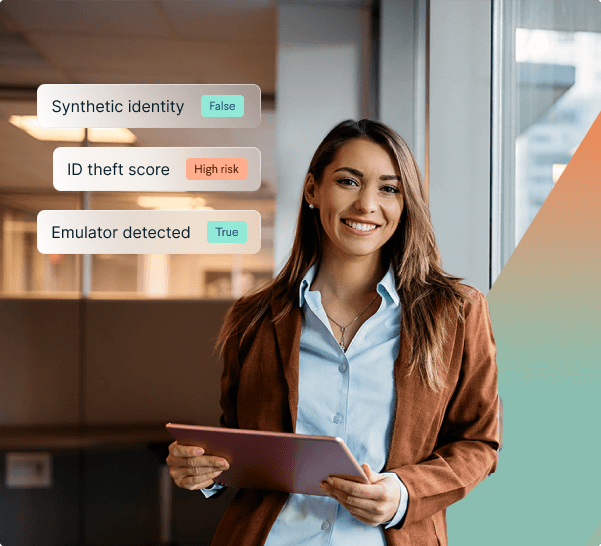Identity Theft And Fraud How It Happens And How To Prevent It
- Anti-Money Laundering (AML)
- Document Verification & Fraud
By SmartSearch
/SmartSearch_OfficeLifestyle_Feb25_049.jpg)
The Covid-19 pandemic has had a huge impact on all aspects of our lives, but undoubtedly one major negative side effect has been a drastic rise in uncertainty, and sadly this has led to a huge increase in identity theft and fraud as scammers attempt to exploit the situation.
Identity theft is when someone’s personal details are stolen. Identity fraud is when those are used to commit fraud. Victims of identity fraud may suffer severe financial loss and often experience ongoing financial issues in terms of their credit record/score - for example, difficulty in getting approval for loans, credit cards or a mortgage.
According to National Fraud Database figures, identity fraud increased by 11% in just the first six months of 2021, in what experts say is a pattern similar to the aftermath of the 2008 financial crisis.
Top six ID theft techniques
1. Stealing your documents
If you throw away rather than shred printed documents containing personal information - bank statements, bills etc thieves are able to go through your bins or recycling boxes to find account numbers, addresses and other sensitive information which they can then use to assume or sell your financial identity.
2. Looking over your shoulder
If you are making a financial transaction on your phone, in a public place, thieves can look over your shoulder and steal your credit card number and CSV code. They may also be able to watch you type in your pin number at a cash machine.
3. Intercepting your post
If you have an outside/separate post box, thieves can go through it, looking for credit card offers, bank or credit card statements, and other personal information. Some will even redirect your mail so they can get hold of sensitive information.
4. Phishing and internet theft
Thieves use email and online pop-ups that appear to be genuinely from your bank or credit card provider. They will often ask you to confirm payment details and then send you to a website that looks genuine, but is fake, and enables them to steal all the information you enter.
5. Fake phone calls
A common technique is when fraudsters call pretending to be your bank, or another business or organisation you already have a relationship with and ask for personal information. Another phone scam is when someone pretending to be your bank calls to say they think you have been a victim of fraud - they pray on your vulnerability, and get you to confirm personal and financial details to try and determine if you have been scammed, and then use that information to scam you themselves.
6. Skimmer devices
Much less widespread, but still a common ID theft/fraud technique is skimming. This is where thieves use hand-held devices which are able to swipe a credit or debit card and copy all the data. Skimmers are small, and discreet, and criminal gangs will often use people working in shops, cafes and restaurants to steal the information while they take a legitimate payment from your card.
Top six identity fraud techniques
Applying for credit cards and loans
Once a fraudster has your ID details they can use them to apply for financial products like credit cards and loans. They take the money and run, racking up huge debts in your name that you are then left liable for
Taking out mobile phone contracts
Another common use of a stolen ID is to apply for a mobile phone contract. Fraudsters apply in the name of the person whose ID they have stolen and spend huge amounts in calls and data. They may also use the phone to communicate with others as part of wider organised crime.
Claiming benefits
A common ruse is to claim benefits with a stolen ID. Fraudsters claim for payments such as child benefit, unemployment, disability benefits, universal credit etc in the name of the person whose ID they have stolen and divert it all to a bank account they have set up in the same name.
Buying and selling goods and services
Identity thieves will use stolen information to buy goods and services, from small purchases through to huge expenditures. They can also use stolen ID to sell assets you already own, such as the recent case where an identity thief managed to sell a man’s home without his knowledge and pocket the proceeds of the sale.
Taking over existing bank accounts and financial products
Once a thief has your personal details, they may well have enough information to access genuine accounts you hold. They can then, posing as you, request new passwords and logins and shut you out of your own accounts.
Obtaining replacement ID documents
In some cases, an ID thief will use the information they have stolen to apply for replacement passports or IDs in that individual’s name. Once they have these IDs it is even easier for them to continue to commit identity fraud.
Six top tips on how to protect yourself against identity fraud
-
Never throw out anything containing personal or financial details without shredding it first, and don’t leave things like bills lying around for others to look at.
-
Your bank will never ask you to reveal your full password, PIN, login details or account numbers over the phone, or via email, so never reveal this information.
-
If you are concerned a call from your bank is not genuine, hang up, and call your bank from another phone.
-
Check bank statements carefully for any transactions you don’t recognise.
-
If you are expecting personal or financial information through the post and it hasn’t arrived, check with the sender to make sure it hasn’t been intercepted.
-
If you move house, make sure you redirect your post for at least a year.
How regulated businesses can help prevent identity fraud
All regulated businesses in the UK, which includes estate agents, solicitors and financial services businesses - must run identification and verification checks on all customers before they do business with them to ascertain:
-
If they are a legitimate person
-
If the ID they are presenting is a legitimate ID
-
If they match that ID
Fake IDs are now so sophisticated, that manual checks alone will not necessarily be able to spot if the customer is who they are claiming to be. The best way for regulated firms to ensure that the person they are doing business with is who they say they are, is to run electronic verification checks using a secure online platform. This will:
-
Identify and verify the ID
-
Use the latest in biometric and selfie technology to ensure the person is who they say they are
-
Screen the individual against PEPs and sanctions
-
Record the result of the check and monitor the details for any changes
To find out how you can protect your business and your customers from identity theft and fraud, get a free SmartSearch demo today https://www.smartsearch.com/get-a-demo
See it in action
Book a personalised demo with an AML expert today!



